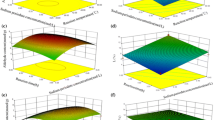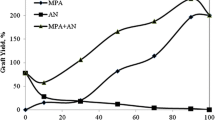Abstract
Anionic modified viscose fiber (AVF) was prepared by using viscose fiber (VF) as raw material, sodium hydroxide as catalyst and sodium chloroacetate as modification reagent. The COOH content of anionic viscose fiber was 109.25 mmol/kg. Anionic viscose fibers were modified with branched polyethylenimine (HPEI) at 140 °C hydrothermal environment using a high-pressure reaction kettle. Zwitterionic viscose fibers (AVF-g-HPEI) with different amino and carboxyl contents could be obtained by changing the ratio of the two modified reagents. Increasing HPEI dosage resulted in amide group content of zwitterionic viscose fibers ranging from 0 to 108.35 mmol/kg. The zwitterionic viscose fibers were characterized by IR, SEM and XPS. IR analysis showed that zwitterionic viscose fiber was successfully prepared. SEM analysis showed that the reaction mainly occurred on the surface of the fiber, and the fiber structure was not changed. XPS analysis demonstrated that with the HPEI dosage increasing nitrogen elements on the surface of zwitterionic viscose fiber increased significantly. Dye adsorption experiments indicated that (1) AVF-g-HPEI could selectively adsorb the anionic dye or the cationic dye (such as methyl orange and methylene blue) from the mixed solution after the pre-treatment with pH 4.5 or pH 10.5 solution, respectively, (2) the dyes adsorbed by zwitterionic viscose fiber could be desorbed in the aqueous solution of pH 4.5 or 10.5, respectively and (3) the desorption ratio of AVF-g-HPEI remained above 0.85 after eight cycles.








Similar content being viewed by others
References
Nagajyoti PC, Lee KD, Sreekanth TVM (2010) Heavy metals, occurrence and toxicity for plants: a review. Environ Chem Lett 8:199–216
Chan CK, Yao X (2008) Air pollution in mega cities in China. Atmos Environ 42:1–42
Wang B, Chen PY, Zhao RX, Zhang L, Chen Y, Yu LP (2020) Carbon-dot modified polyacrylonitrile fibers: recyclable materials capable of selectively and reversibly adsorbing small-sized anionic dyes. Chem Eng J 391:123484
Esterkin CR, Negro AC, Alfano OM, Cassano AE (2005) Air pollution remediation in a fixed bed photocatalytic reactor coated with TiO2. AIChE J 51:2298–2310
Kurniawan TA, Chan GYS, Lo WH, Babel S (2006) Physico–chemical treatment techniques for wastewater laden with heavy metals. Chem Eng J 118:83–98
Comninellis C, Kapalka A, Malato S, Parsons SA, Poulios L, Mantzavinos D (2008) Advanced oxidation processes for water treatment: advances and trends for R&D. J Chem Technol Biol 83:769–776
Mishra AK, Arockiadoss T, Ramaprabhu S (2010) Study of removal of azo dye by functionalized multi walled carbon nanotubes. Chem Eng J 162:1026–1034
Tichonovas M, Krugly E, Racys V, Hippler R, Kauneliene V, Stasiulaitiene I, Martuzevicius D (2013) Degradation of various textile dyes as wastewater pollutants under dielectric barrier discharge plasma treatment. Chem Eng J 229:9–19
Ibrahim M, Labaki M, Giraudon JM, Lamonier JF (2020) Hydroxyapatite, a multifunctional material for air, water and soil pollution control: a review. J Hazard Mater 383:121139
Wen MC, Li GY, Liu HL, Chen JY, An TC, Yamashita H (2019) Metal-organic framework-based nanomaterials for adsorption and photocatalytic degradation of gaseous pollutants: recent progress and challenges. Environ Sci Nano 6:1006–1025
Mahmood A, Shi GS, Xie XF, Sun J (2019) Adsorption mechanism of typical oxygen, sulfur, and chlorine containing VOCs on TiO2 (001) surface: first principle calculations. Appl Surf Sci 471:222–230
Ao CH, Lee SC (2005) Indoor air purification by photocatalyst TiO2 immobilized on an activated carbon filter installed in an air cleaner. Chem Eng Sci 60:103–109
Zhang ZH, Xu Y, Ma XP, Li FY, Liu DN, Chen ZL, Zhang FQ, Dionysiou DD (2012) Microwave degradation of methyl orange dye in aqueous solution in the presence of nano-TiO2-supported activated carbon (supported-TiO2/AC/MW). J Hazard Mater 209:271–277
Trevino-Cordero H, Juarez-Aguilar LG, Mendoza-Castillo DI, Hernandez-Montoya V, Bonilla-Petriciolet A, Montes-Moran MA (2013) Synthesis and adsorption properties of activated carbons from biomass of Prunus domestica and Jacaranda mimosifolia for the removal of heavy metals and dyes from water. Ind Crop Prod 42:315–323
Tseng RL, Tseng SK (2006) Characterization and use of high surface area activated carbons prepared from cane pith for liquid-phase adsorption. J Hazard Mater 136:671–680
An YX, Fu Q, Zhang DH, Wang YY, Tang ZL (2019) Performance evaluation of activated carbon with different pore sizes and functional groups for VOC adsorption by molecular simulation. Chemosphere 227:9–16
Ren XM, Chen CL, Nagatsu M, Wang XK (2011) Carbon nanotubes as adsorbents in environmental pollution management: a review. Chem Eng J 170:395–410
Zhang ZY, Kong JL (2011) Novel magnetic Fe3O4@C nanoparticles as adsorbents for removal of organic dyes from aqueous solution. J Hazard Mater 193:325–329
Zhao Y, Chen HL, Li J, Chen CL (2015) Hierarchical MWCNTs/Fe3O4/PANI magnetic composite as adsorbent for methyl orange removal. J Colloid Interf Sci 450:189–195
Xie LT, Liu DH, Huang HL, Yang QY, Zhong CL (2014) Efficient capture of nitrobenzene from waste water using metal-organic frameworks. Chem Eng J 246:142–149
Vikrant K, Cho M, Khan A, Kim KH, Ahn WS, Kwon EE (2019) Adsorption properties of advanced functional materials against gaseous formaldehyde. Environ Res 178:108672
Wang S, Lee YN, Nam H, Kim HK (2019) Chemical activation of porous diatomite ceramic filter for the adsorption of TMA, H2S, CH3COOH and NH3: isotherm and kinetic studies. J Environ Chem Eng 7:103481
Ilgin P, Gur A (2015) Synthesis and characterization of a new fast swelling poly(EPMA-co-METAC) as superabsorbent polymer for anionic dye absorbent. Iran Polym J 24:149–159
Ilgin P, Ozay O (2017) Novel stimuli-responsive hydrogels derived from morpholine: synthesis, characterization and absorption uptake of textile azo dye. Iran Polym J 26:391–404
Zhu C, Xia Y, Zai Y, Dai Y, Liu X, Bian J, Liu Y, Liu J, Li G (2019) Adsorption and desorption behaviors of HPEI and thermoresponsive HPEI based gels on anionic and cationic dyes. Chem Eng J 369:863–873
Mittal A, Malviya A, Kaur D, Mittal J, Kurup L (2007) Studies on the adsorption kinetics and isotherms for the removal and recovery of methyl orange from wastewaters using waste materials. J Hazard Mater 148:229–240
Zhang F, Zhao ZS, Tan RQ, Guo YQ, Cao LJ, Chen L, Li J, Xu W, Yang Y, Song WJ (2012) Selective and effective adsorption of methyl blue by barium phosphate nano-flake. J Colloid Interf Sci 386:277–284
Fan Y, Liu HJ, Zhang Y, Chen Y (2015) Adsorption of anionic MO or cationic MB from MO/MB mixture using polyacrylonitrile fiber hydrothermally treated with hyperbranched polyethylenimine. J Hazard Mater 283:321–328
Xu G, Wang L, Xie YJ, Tao ML, Zhang WQ (2018) Highly selective and efficient adsorption of Hg2+ by a recyclable aminophosphonic acid functionalized polyacrylonitrile fiber. J Hazard Mater 344:679–688
Meng L, Xu XH, Bai B, Ma ML, Li S, Hu N, Wang HL, Suo YR (2018) Surface carboxyl-activated polyester (PET) fibers decorated with glucose carbon microspheres and their enhanced selective adsorption for dyes. J Phys Chem Solid 123:378–388
Plens ACO, Monaro DLG, Coutinho AR (2015) Adsorption of SOX and NOX in activated viscose fibers. An Acad Bras Cienc 87:1149–1160
Carrillo A, Colom X, Sunol JJ, Saurina J (2004) Structural FTIR analysis and thermal characterization of lyocell and viscose-type fibers. Eur Polym J 40:2229–2234
Li WB, Ke GZ, Li GW, Xu WL (2015) Study on the structure and properties of viscose/wool powder blended fiber. Fiber Text East Eur 23:26–29
Bychkova EV, Panova LG, Artemenko SE, Kushelev YV (2001) Viscose fibers with low inflammability. Fiber Chem 33:16–19
Peršin Z, Devetak M, Drevenšek-Olenik I, Vesel A, Mozetič M, Stana-Kleinschek K (2013) The study of plasma's modification effects in viscose used as an absorbent for wound-relevant fluids. Carbohyd Polym 97:143–151
Wang WC, Zhang P, Zhang S, Li FX, Yu JY, Lin JY (2013) Structure and properties of novel regenerated cellulose fibers prepared in NaOH complex solution. Carbohyd Polym 98:1031–1038
Perepelkin KE (2005) Principles and methods of modification of fibers and fiber materials: a review. Fiber Chem 37:123–140
Lin RJ, Zhuang LZ, Xu XZ, Chen SX (2013) Design of a viscose based solid amine fiber: effect of its chemical structure on adsorption properties for carbon dioxide. J Colloid Interf Sci 407:425–431
Emam HE, Bechtold T (2015) Cotton fabrics with UV blocking properties through metal salts deposition. Appl Surf Sci 357:1878–1889
Emam HE, El-Hawary NS, Ahmed HB (2017) Green technology for durable finishing of viscose fibers via self-formation of AuNPs. Int J Biol Macromol 96:697–705
Zhang CX, Ren J, Ma YM, Liu Y, Tang YF, Qin SC (2018) Preparation and adsorption properties of amphoteric viscose fiber. Iran Polym J 27:635–644
Chiou MS, Li HY (2002) Equilibrium and kinetic modeling of adsorption of reactive dye on cross-linked chitosan beads. J Hazard Mater 93:233–248
Shi Y, Xue Z, Wang X, Wang L, Wang A (2013) Removal of methylene blue from aqueous solution by sorption on lignocellulose-g-poly(acrylic acid)/montmorillonite three-dimensional cross-linked polymeric network hydrogels. Polym Bull 70:1163–1179
Liu HJ, Chen Y, Zhu DD, Shen Z, Stiriba SE (2007) Hyperbranched polyethylenimines as versatile precursors for the preparation of different type of unimolecular micelles. React Funct Polym 67:383–395
Liu QX, Zhou YR, Wang M, Zhang Q, Ji T, Chen TY, Yu DC (2019) Adsorption of methylene blue from aqueous solution onto viscose-based activated carbon fiber felts: kinetics and equilibrium studies. Adsorpt Sci Technol 37:312–332
Huang GQ, Li WT, Liu Q, Liu JY, Zhang HS, Li RM, Li ZS, Jing XY, Wang J (2018) Efficient removal of uranium (VI) from simulated seawater with hyperbranched polyethylenimine (HPEI)-functionalized polyacrylonitrile fibers. New J Chem 42:168–176
Acknowledgements
The author is grateful for the financial support of the Research Project of Shengli College, China University of Petroleum (KY2018002) and Science Development Foundation of Dongying (DJ2020026).
Author information
Authors and Affiliations
Corresponding author
Ethics declarations
Conflict of interest
There are no conflicts to declare.
Rights and permissions
About this article
Cite this article
Zhang, C., Liu, Y. Selective adsorption of zwitterionic viscose fiber treated with sodium chloroacetate and hyperbranched polyethylenimine. Iran Polym J 30, 57–65 (2021). https://doi.org/10.1007/s13726-020-00872-y
Received:
Accepted:
Published:
Issue Date:
DOI: https://doi.org/10.1007/s13726-020-00872-y




